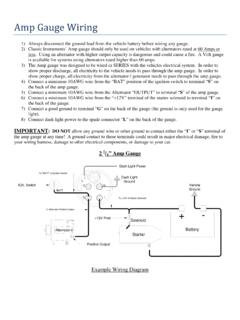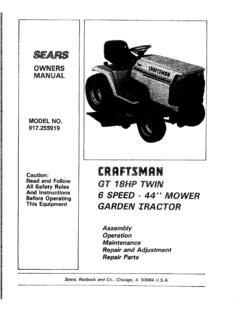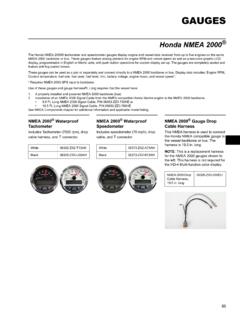Transcription of 1967-1968 Camaro - Classic Instruments
1 1967-1968 Camaro installation Manual Revised: September 13, 2013 Table of Contents Table of Contents .. II Welcome to the Team of Classic Instruments ! .. III Remove Original Instrument Panel .. 1 Determine Speedometer 2 Wiring the Speedometer .. 3 Determine Tachometer Signal .. 5 Wiring the Tachometer .. 6 Wiring the Temperature gauge .. 7 Wiring the Oil Pressure gauge .. 8 Wiring the fuel Level gauge .. 9 Wiring the High Beam 9 Wiring the Turn Signals .. 9 Wiring the Dash Lights .. 9 Instrument Panel Wire Harness .. 10 Calibrating the Speedometer .. 11 SN16 Pulse Signal Generator Signal .. 11 SN74 Speedometer Signal Interface Signal .. 12 16-Pulse Speedometer 16,000 PPM Calibration Chart.
2 15 Mount New Instrument Panel .. 16 Revised: September 13, 2013 Welcome to the Team of Classic Instruments ! Our congratulations and appreciation for your purchase of the finest quality set of specialty Instruments ever produced! Your instrument set has been conceived, designed, and manufactured by Classic Instruments , Inc. in the Each instrument has been tested and certified for accuracy and quality before packaging and shipping. For trouble-free installation and operation, follow the instructions exactly as outlined. Your Instruments were assembled to precise specifications and although each has a five (5) year warranty covering defective parts and workmanship this warranty will not cover Instruments or sending units which have been installed incorrectly.
3 Follow our recommended procedures for installation and proper hookup to maintain the value and appearance of your instrument set during many future years of accurate and dependable service! SPECIAL NOTES: Due to rapid changes in technology, some Instruments may not be included in this manual. In this situation please refer to special instruction sheets and stickers located on your instrument. Please call us at 1-800-575-0461 with any questions. Follow our instructions to guarantee trouble-free installation and correct operation. Our installation instructions and procedures should take priority over instructions furnished by any other manufactures of ignition systems, wiring harnesses, gauges, etc.
4 TECHNICAL ASSISTANCE 1-800-575-0461 OR Visit our new website for the latest in gauge design and updates to our installation manual at: Revised: September 13, 2013 Remove Original Instrument Panel Step1: Disconnect the battery before beginning the replacement of the old instrument panel. Step 2: Remove the 7 screws holding the instrument panel to the dash. Three screws are located at the top of the instrument panel and four screws are located at the bottom of the instrument panel. Save these screws to use when installing the new instrument panel. Step 3: Unplug the old instrument panel wire harness from the vehicle wire harness. Step 4: Remove the two screws holding the high beam indicator light assembly and remove the assembly from the old instrument panel.
5 Save the screws and light assembly to install on the new instrument panel. Step 5: Remove the old instrument panel from the dash. See Figure A Below Figure A: Instrument panel dash mounting screw locations Revised: September 13, 2013 Determine Speedometer Signal Determine where you are going to get the speed signal for your speedometer. If your transmission has a fitting for a mechanical speedometer cable, you will need a pulse signal generator. The GM style pulse signal generator (part #SN16) is shown below in Figure B. The SN16 produces 16 pulses per revolution and a 12V square wave signal. If your transmission has a built-in electric vehicle speed sensor (VSS) or computer (ECM), a speedometer signal interface is required, shown below in Figure C.
6 RedBlackWhite Red: +12 VDC Black: Ground White: Signal Figure B: GM style pulse signal generator [SN16] Classic Instruments GNDGROUNDPOWERPUSHBUTTONPUSHBUTTONSENSOR PWRCRUISE4SN74 SPEEDOMETERSIGNALINTERFACESW#1 Input Type LED#2 Sensitivity #1 ADJ#3 Output Type #2 AUTO#4 not used 1 & 2 reset Figure C: Speedometer signal interface [SN74] Revised: September 13, 2013 Wiring the Speedometer Step 1: Connect +12 VDC from the accessory side of the ignition switch to the Pink/White wire on the speedometer connector (position F) of the instrument wire harness. If accessory of ignition is not available, connect to a switched and dedicated fuse on the fuse panel. This will help prevent interference to the speedometer from the power source.
7 Step 2: Connect the red wire from the pulse signal generator OR Power from the SN74 to the Purple/White wire on the speedometer connector (position C) of the instrument wire harness. Step 3: Connect a dedicated chassis ground ( don t stack with any other ground wires) to the black/white wire on the speedometer connector (position E) of the instrument wire harness. This will help prevent interference to the speedometer from the ground. Step 4: Connect the black wire from the pulse signal generator OR Ground from the SN74 to the Yellow wire on the speedometer connector (position A) of the instrument wire harness. Step 5: Connect the white wire from the pulse signal generator OR Output from the SN74 to the Purple wire on the speedometer connector (position B) of the instrument wire harness.
8 Step 6: If using the SN74 speed signal interface: Connect one wire of the transmission VSS to the SN74 Sensor Gnd and the other wire of the transmission VSS to the SN74 Input . OR Connect the speed signal wire from the ECM/PCM to the SN74 Input . Revised: September 13, 2013 Classic Instruments GNDGROUNDPOWERPUSHBUTTONPUSHBUTTONSENSOR PWRCRUISE4SN74 SPEEDOMETERSIGNALINTERFACESW#1 Input Type LED#2 Sensitivity #1 ADJ#3 Output Type #2 AUTO#4 not used 1 & 2 reset1, 2 ON3, 4 OFFTo Purple/White harness wireTo Yellow harness wireFrom ECM/PCM speed signalTo Purple harness wireTo pushbuttonTo pushbutton ECM/PCM Speed Signal Wiring Classic Instruments GNDGROUNDPOWERPUSHBUTTONPUSHBUTTONSENSOR PWRCRUISE4SN74 SPEEDOMETERSIGNALINTERFACESW#1 Input Type LED#2 Sensitivity #1 ADJ#3 Output Type #2 AUTO#4 not used 1 & 2 reset1, 2, 3.
9 4 OFFTo Purple/White harness wireTo Yellow harness wireTo Purple harness wireTo pushbuttonTo pushbuttonFrom VSS low signalFrom VSS high signal Electronic VSS Speed Signal Wiring To Purple/White Harness WireTo Yellow Harness WireTo Purple Harness WireWhiteBlackRed Pulse Signal Generator Wiring Revised: September 13, 2013 Determine Tachometer Signal STANDARD POINTS & CONDENSER SYSTEM Signal comes from the negative side of the coil (usually marked as - ). GMC HEI (High Energy Ignition System) Signal comes from the TACH terminal on coil side of distributor cap. MSD (Multiple Spark Discharge System) Signal comes from the TACH post on the MSD box. If there isn t a MSD box, the signal comes from the negative side of the coil.
10 If the tachometer does not respond correctly, your MSD system may require a MSD TACH adapter. Part No. 8910 or 8920. Contact MSD to find out which adapter you should use for your application. VERTEX MAGNETO SYSTEM Signal comes from the KILL terminal on side the of Vertex magneto body. An external adapter such as an MSD Pro Mag Tach Converter #8132 may be required. ACCEL IGNITION COILS Signal comes from the negative side of the coil. CAUTION! Some Accel ignition coils require the tach signal wire to be connected to the + terminal on the coil! PLEASE carefully read Accel s instructions before connecting ignition coil. MALLORY IGNITION Signal comes from the negative side of coil (usually marked as - ).










